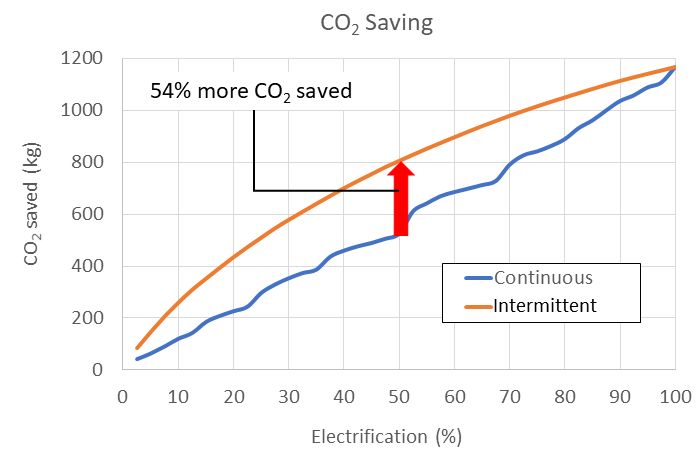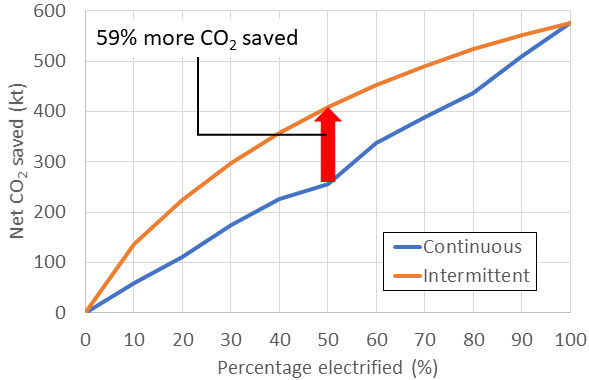The journal of Railway Engineering Science has published my most recent paper, entitled An investigation into intermittent electrification strategies and an analysis of resulting CO2 emissions using a high-fidelity train model. The paper is open access and freely downloadable.
(Intermittent electrification means electrifying parts of a rail route, rather than the whole thing.)
Paper Overview (TL;DR)
We used a model of a train to investigate how intermittent electrification can help reduce carbon dioxide emissions in the near term. (The long-term goal should be to electrify everything!)
Using intermittent electrification can reduce carbon dioxide emissions by 54%, increasing to 59% if we include the CO2 embodied in the electrification infrastructure.
Motivation
Electrification is expensive, costing around £1.5 million – £2.5 million per single-track kilometre. It also takes a long time – these are large infrastructure projects that take time to deliver. Instead of continuously electrifying from (e.g.) London outward, intermittent electrification could reduce cost and provide decarbonisation faster.
As we already had a rail vehicle model from previous work, we used this to investigate!
The Rail Vehicle Model
The rail vehicle model was based on the model developed in earlier work. Next, it was extended to include the intermittent electrification to allow it to switch between overhead line equipment (OLE) and the on-board diesel engine.
Intermittent Electrification Model Results
We ran the model over the route from London Paddington to Plymouth in both diesel and electric modes. Next, we compared the two, which showed us where CO2 emissions were the greatest along the route.

This allowed us to check how electrification would affect the carbon dioxide emissions of the route. We found that 50% of the carbon dioxide savings came from electrification of 30% of the track!

In fact, intermittent electrification produced higher carbon dioxide savings than continuous electrification across the board!

Whole-life Carbon Dioxide Emissions
Until this point, we had been looking at ‘operational’ carbon dioxide emissions. (These are emissions that come about from running the trains on the railway.)
However, electrifying track requires steel, concrete and machinery to string up the wires, all of which produce carbon dioxide. So, the next step of our analysis investigated the ‘whole-life’ emissions of the railway, including an estimate for the carbon dioxide emitted during electrification.
Including industry-recognised numbers for the carbon cost of electrification, we found that intermittent electrification saved up to 59% more carbon dioxide than continuous electrification.

Caveats
This research showed some interesting conclusions, but there are two main caveats to bear in mind:
- I am not a life-cycle analysis (LCA) expert. I have taken industry-standard numbers and used them in this analysis.
- There are operational and logistical difficulties with electrifying intermittently. Not least, electrifying in this way may require more transformers/electrification infrastructure than doing so in a continuous manner.
With these in mind though, this paper goes some way toward making the case for intermittent electrification to speed up the decarbonisation of the UK’s rail network.
Other Work
For more information on my research, please check out my Research page. If you’re interested particularly in rail or road vehicles, then please check out the relevant pages.